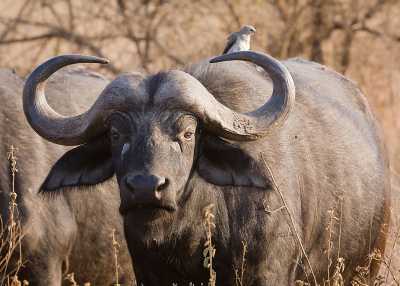 SKC Films Library SKC Films Library |
| SKC Films Library >> Science >> Zoology >> Mammals >> Order Artiodactyla >> Family Bovidae |
| Cape Buffalo Syncerus caffer (aka African buffalo, forest buffalo, savanna buffalo) Description This member of the cattle sub-family has a heavy-set body, with stocky legs, a large head, and short neck. Body length ranges from 6 to 11 feet, shoulder height from 3 to 5.5 feet, and weight from 660 to 2,000 pounds; males tend to be larger than females. Both sexes have horns, which are hook-shaped, curving first downwards and then hooking up and inwards, and growing up to 5 feet long. The horns of males are larger than females, and in males the bases of the horns expand into a distinctive feature known as a "boss."
The forest buffalo (Syncerus caffer nanus) is the smallest of the four recognized subspecies, and has a reddish to dark red-brown coat, and smaller, swept-back horns (no more than 1.3 feet lomg). Distinctive white tassels hang from the tips of the forest buffalo's ears. There are three forms of the savanna buffalo, the West African savanna buffalo (S. c. brachyceros), the central African savanna buffalo (S. c. aequinoctialis) and the southern Savanna buffalo (S. c. caffer). Of these, the southern savanna buffalo, or cape buffalo, is the largest. Distribution and Habitat African buffalo are found in a variety of habitats, including open savannah, woodlands, and rainforest, but always within a day's walk of water. Once ranging widely in sub-Saharan Africa, the distribution of this species has shrunk due to hunting and disease issues, and today few populations exist outside the confines of national parks and large conservation areas. Habits and Behaviors Cape buffalo may be active throughout the day and night. On average, 18 hours per day are spent foraging and moving. Savannah buffalo live in large herds of 50-500 animals, comprised of smaller subgroups of bachelor males, females and their young, or juveniles. Old males may be solitary. Forest buffalo live in smaller mixed herds of 8-20 animals. Herds usually occupy a stable home range, which in savannah buffalo may be up to 415 square miles in size. Herds will stick together and may charge as a unit when threatened, a tactic which ensures that predators have difficulty preying on even young and feeble animals. A herd of buffalo are easily capable of driving away a whole pride of lions to protect a herd member. African buffalo are very dangerous when cornered or injured, and even a seriously wounded one is capable of inflicting considerable damage on whomever or whatever caused its wound. Diet Buffalo are strict herbivores, feeding exclusively on grasses. Reproduction Cape buffalo will breed year-round if conditions allow, but where water is scarce most births occur during the wet season. Gestation takes about 340 days. At birth, the calf is lighter than the adults; baby savannah buffalo are usually dark reddish-brown, while baby forest buffalo are usually bright red. The bond between the mother and calf is very strong, and within just a few hours, the newborn calf is capable of keeping up with its herd. It will be weaned at about 6 months, and will reach sexual maturity at 3.5-5 years. Scientific Classification phylum Chordata |
| SKC Films Library >> Science >> Zoology >> Mammals >> Order Artiodactyla
>> Family
Bovidae This page was last updated on June 12, 2017. |
